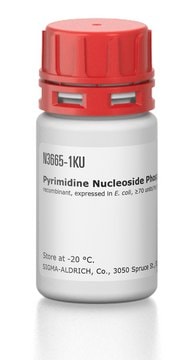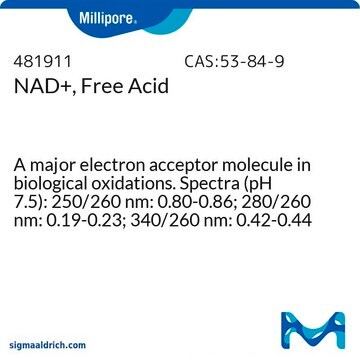N1290
Polynucleotide phosphorylase human
Synonym(e):
Polyribonucleotide nucleotidyltransferase
Anmeldenzur Ansicht organisationsspezifischer und vertraglich vereinbarter Preise
Alle Fotos(1)
About This Item
Empfohlene Produkte
Rekombinant
expressed in E. coli
Form
solution
enzyme activity
≥20 units/mg protein
Mol-Gew.
~90 kDa
Konzentration
400-600 μg/mL protein
Versandbedingung
dry ice
Lagertemp.
−70°C
Biochem./physiol. Wirkung
Polynucleotide phosphorylase (PNPase) is a bifunctional enzyme with a phosphorolytic 3′ to 5′ exoribonuclease activity and a 3′-terminal oligonucleotide polymerase activity. It is also involved in mRNA processing and degradation in bacteria, plants, and humans.
Physikalische Form
supplied as a solution in 20 mM HEPES buffer, pH 7.9, with 0.1 mM EDTA, 2 mM DTT, 12.5 mM MgCl2, ~130 mM KCl, and 20% (w/v) glycerol.
Lagerklassenschlüssel
12 - Non Combustible Liquids
WGK
WGK 1
Flammpunkt (°F)
Not applicable
Flammpunkt (°C)
Not applicable
Analysenzertifikate (COA)
Suchen Sie nach Analysenzertifikate (COA), indem Sie die Lot-/Chargennummer des Produkts eingeben. Lot- und Chargennummern sind auf dem Produktetikett hinter den Wörtern ‘Lot’ oder ‘Batch’ (Lot oder Charge) zu finden.
Besitzen Sie dieses Produkt bereits?
In der Dokumentenbibliothek finden Sie die Dokumentation zu den Produkten, die Sie kürzlich erworben haben.
Lukasz S Borowski et al.
Biochimica et biophysica acta, 1797(6-7), 1066-1070 (2010-02-02)
Protein complexes responsible for RNA degradation play important role in three key aspects of RNA metabolism: they control stability of physiologically functional transcripts, remove the unnecessary RNA processing intermediates and destroy aberrantly formed RNAs. In mitochondria the post-transcriptional events seem
Robert N Rainey et al.
Molecular and cellular biology, 26(22), 8488-8497 (2006-09-13)
Polynucleotide phosphorylase (PNPase) is an exoribonuclease and poly(A) polymerase postulated to function in the cytosol and mitochondrial matrix. Prior overexpression studies resulted in PNPase localization to both the cytosol and mitochondria, concurrent with cytosolic RNA degradation and pleiotropic cellular effects
Hsiao-Wen Chen et al.
Molecular and cellular biology, 26(22), 8475-8487 (2006-09-13)
We recently identified polynucleotide phosphorylase (PNPase) as a potential binding partner for the TCL1 oncoprotein. Mammalian PNPase exhibits exoribonuclease and poly(A) polymerase activities, and PNPase overexpression inhibits cell growth, induces apoptosis, and stimulates proinflammatory cytokine production. A physiologic connection for
Victoria Portnoy et al.
RNA (New York, N.Y.), 14(2), 297-309 (2007-12-18)
PNPase is a major exoribonuclease that plays an important role in the degradation, processing, and polyadenylation of RNA in prokaryotes and organelles. This phosphorolytic processive enzyme uses inorganic phosphate and nucleotide diphosphate for degradation and polymerization activities, respectively. Its structure
Takashi Nagaike et al.
The Journal of biological chemistry, 280(20), 19721-19727 (2005-03-17)
Mammalian mitochondrial (mt) mRNAs have short poly(A) tails at their 3' termini that are post-transcriptionally synthesized by mt poly(A) polymerase (PAP). The polyadenylation of mt mRNAs is known to be a key process needed to create UAA stop codons that
Unser Team von Wissenschaftlern verfügt über Erfahrung in allen Forschungsbereichen einschließlich Life Science, Materialwissenschaften, chemischer Synthese, Chromatographie, Analytik und vielen mehr..
Setzen Sie sich mit dem technischen Dienst in Verbindung.







